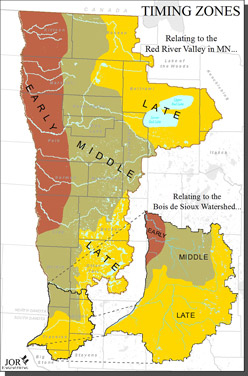Timing Zones

Flood Damage Reduction (FDR) Strategy
Flood damage reduction efforts can take many forms, but we will focus on three major options that provide widespread benefits: impoundments, culvert sizing, and land-use change. Each method is useful and when combined can have a major impact on flood control. In selecting alternatives we must analyze the hydrologic characteristics of the basin. Certain areas due to land-use, soil type, topography and location should be treated differently. The Timing Zones map shows three zones: early, middle and late relative flood flow contribution to the Red River Valley in MN and to the Bois de Sioux Watershed. The early zone in the Bois de Sioux Watershed is close to the Bois de Sioux River and water from this area could leave the watershed soon after a storm event while the channel at Wahpeton/Breckenridge can handle the flow. However, this area is in the middle zone of the Red River Basin so downstream impacts on the Red River need to be carefully considered. Waters in the middle and late zones should be slowed and or stored until the downstream areas can handle the increased volume of water. The late zone, in particular, is a great place to implement projects that detain or retain water.
IMPOUNDMENTS
The basic concept of an impoundment is to create a location for water to be stored during an event and then released when downstream areas can better handle the flow. A nice feature of an impoundment is the ability to design to an appropriate level of storage and be able to manipulate the inflow and outflow of water. Impoundments can also improve water quality by provide flood waters a place for sediments and nutrients to settle. Impoundments may also include other natural resource enhancements (NRE) like wildlife habitat, stream flow augmentation, and improved fisheries.
CULVERT SIZING
Culvert sizing implements an inexpensive and fair FDR approach. Culvert sizing can control the hydrologic conditions in an area.
LAND-USE CHANGES
Runoff is affected by the type of ground cover it is traveling through. Concrete, bare earth, native prairie, cropland, etc. each effect runoff differently based on their individual characteristics. These affect travel rates, absorbency and ability to filter sediments and nutrients to improve water quality.
SHARED RESPONSIBILITY
The best response lies in the ability to recognize that flood damage reduction in a fertile region like the Red River Valley is a “shared responsibility” among everyone. From local residents to state/federal agencies, we need to focus on critical areas that are prone to flooding, while limiting negative impacts on downstream areas. In fact, if done with the “big picture” mentality, the benefits can be felt among communities all the way north to the Hudson Bay.
